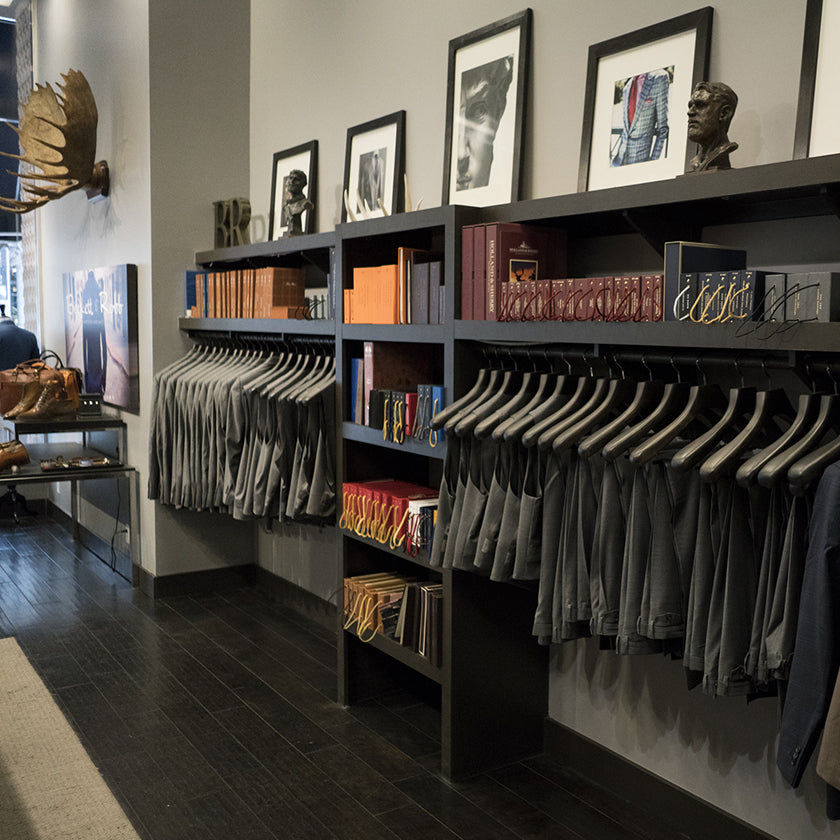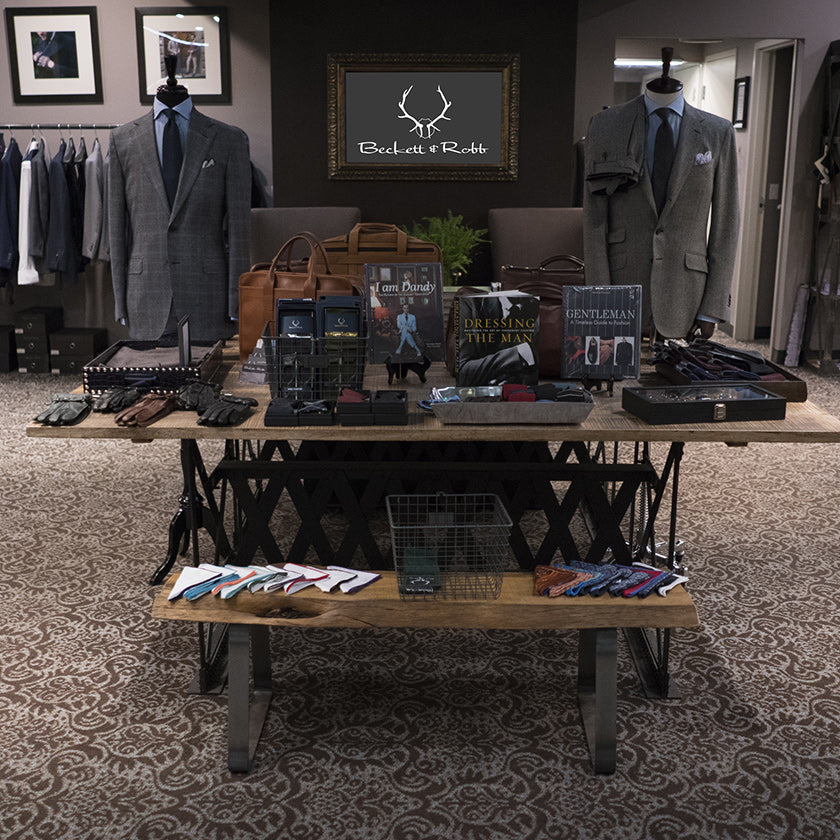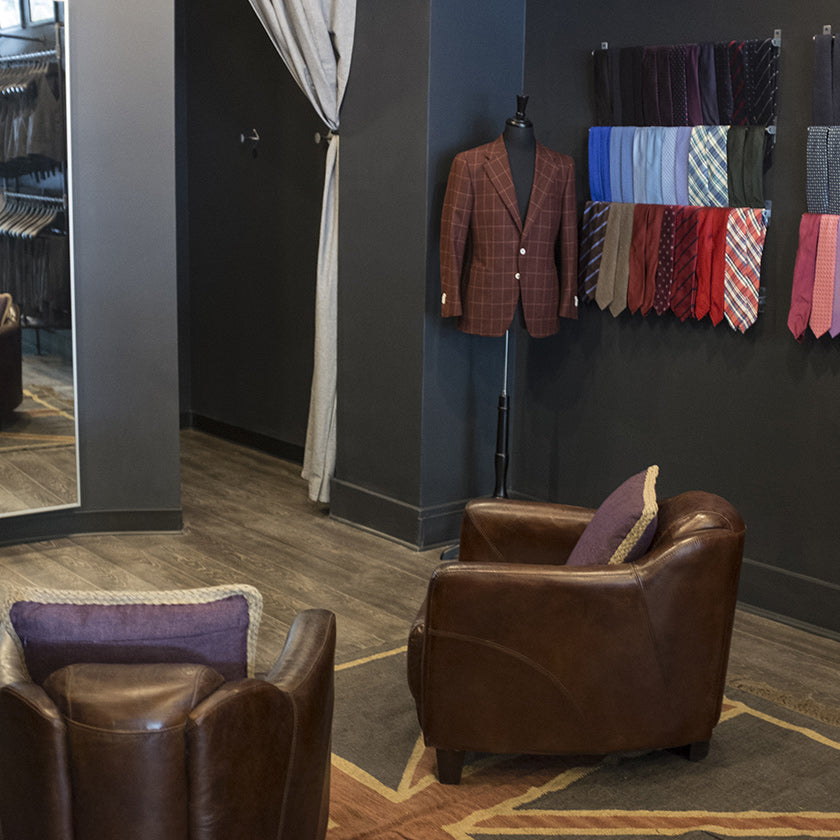Suit Jacket Construction
We offer 3 types of construction in for the chest of our suits, namely full canvas, half canvas, and unstructured (no canvas). We offer 4 types of shoulder options, namely extra padding, normal padding, light padding, and no padding. We also offer 3 types of lining options, namely full lining, half lining, and no lining. While in theory these construction options can be chosen independently of each other to create many different combinations, the number of combinations will seem daunting to many clients. It’s important to note that we have 3 standard combinations that we use as the basis of our construction methods, which are the options most commonly presented to clients: 1) full canvas with full lining and normal shoulder padding, 2) half canvas with full lining and normal shoulder padding), and 3) unstructured with no lining and no shoulder padding. For most clients, these options are more than adequate.
We can, however, also do others combinations by varying the shoulders, canvassing, and lining of the jacket, all based on the client’s preferences or to create an ideal fit based on body type. We provide these options because we’re capable of it and because we love our craft. We provide this explanation because we value transparency and education. See below for more explanation about options for chest construction, shoulder padding, and lining, and if in doubt about which construction method or combination will benefit you most, speak with your Beckett & Robb style consultant during your visit.
Chest Construction
Full Canvas
Our full canvas construction (also called traditional construction, as this is the most traditional and highest level of tailoring) uses natural materials, all made in Italy, to create a jacket with supple structure and shape. These materials include wool canvas, haircloth (made with horsehair and cotton), wrapped haircloth, and felt. All materials are preshrunk so no shrinkage takes place on the finished garment. The wool canvas piece covers the front of the jacket, and is made up of a wool warp and a cotton and horsehair weft. The haircloth is covered in soft felt (horsehair is stout and springy, which gives the haircloth structure and promotes shape, but is scratchy against the skin) at the area of the chest. The canvas starts at the top of the shoulder and extends the length of the jacket front to the hem, also extending into the lapel. The lapel is padded (stitched together using hundreds of small stitches in a way that combines several pieces of cloth and holds them in place to maintain a specific shape) to give the lapel “roll”. Roll is the curl of the lapel as it comes away from the chest, and can only be achieved using high quality canvas that has been pad stitched into place. The rolled lapel is both beautiful as well as functional. It helps the lapel hug the chest and not slouch away from it, a sign of a well-made suit jacket. By contrast, a fused or inferiorly made suit has a flat lapel, with no roll. In addition to the lapel, pad stitching is used in the chest to give it shape. Tailoring, after all, is creating a garment that will fit around and flatter the contours of body, not simply hang from it, like flat sewing. Pad stitching is also done on the canvas of the collar to give good shape and ensure the collar lays properly. The shell cloth (the wool cloth visible on the outside of the suit) is basted together with the canvas interlining, from the top of the shoulders down to the hem. This provides stability and even distribution of the interlining as the canvas interlining and the shell cloth are sewn together at the edges. Once that is finished, the basting is removed during pressing and final preparation, and the result is a tailored garment with a floating canvas. Sleeves are set into the sleeve head entirely by hand for precision and to give a bit of elasticity for comfort at the shoulder seam. Shoulders are composed of the best quality canvas and cotton to provide structured softness. The finishing touches include genuine horn, corozo, or mother-of-pearl buttons and cupro lining (commonly known by the brand name “Bemberg”), which provides vivid color, silky touch, and the breathability of the cotton from which its derived.
Half Canvas
Our half canvas construction uses the same high-quality materials as our full canvas construction. Where a full canvas goes from top to bottom of the jacket front, a half canvas stops around the top button. Like a full canvas, the jacket front construction begins by stitching the pieces together (wool canvas, haircloth, wrapped haircloth, and felt). The shell cloth (the main cloth on the outside of the suit) is then basted (stitched) together to the canvas and chest piece. The lapels are pad stitched to give roll to the lapel. The collar is pad stitched as well to provide good shape. The top half of sleeves are sewn into the sleeve head on half canvas jackets by hand to give elasticity and precise alignment. As with full canvas construction, structure is given to the shoulder using thin, high quality shoulder pads and minimal cotton wadding to give a clean look to the chest and shoulders that is also soft and supple to the touch. The principal areas that differ from full canvas construction is the area below the top button (which has no haircloth), the collar (which has no canvas or pad stitching in a half canvas garment), and the sleevehead (which is set on the top half by hand and the lower half by machine instead of entirely by hand). For many, half canvas is a great alternative to the extra time and cost for full canvas because it still provides the main benefits of a traditional garment, namely the structure in the chest and the roll of the lapel. Like full canvas, our half canvas suits come standard with options for genuine horn, corozo, or mother-of-pearl buttons and cupro linings.
Unstructured and Unlined
This construction creates a natural silhouette, and is especially soft due to very minimal materials and padding used inside. To the uninitiated the jacket can appear quite normal from the outside. Upon closer inspection, it’s evident that the jacket follows very closely the slope and shape of the wearer’s shoulders and chest. This is because there is essentially no padding at the shoulder, no wadding in the sleevehead, and no wool canvas or haircloth in the interior. The jacket is also completely unlined except for the cupro lining in the sleeves. The interior does have a self-cloth facing (also called buggy lining) that attaches at mid-underarm and angles to the bottom of the jacket, adding a bit of structure and a place for interior pockets to be placed. All seams are neatly done and covered with a narrow strip of lining cloth. Because of the exposed nature of the inside of the jacket, it’s a more time consuming process to create an unstructured jacket than half canvas construction. The jacket can be adorned with our standard horn, corozo, or mother-of-pearl button options. Many love the comfort of this natural shoulder construction for sport jackets (and especially for warmer weather since the jacket is light and open). Due to the lack of structure throughout the garment, this style embraces a casual elegance, with a bit of rumpling and natural movement of the cloth instead of the cleaner, more structured lines of a canvassed garment.
Shoulder padding
Extra padding
A more substantial pad than our standard, created by a combination of an extra layer of canvas together with more padding to provide a higher and more structured shoulder. Suitable for full canvas and half canvas construction.
Normal padding
A common option for half canvas and full canvas construction. The pad is made of soft cotton enclosed by a soft felt.
Light padding
This option provides very minimal structure to the shoulder by using a single layer of canvas surrounded by thin, soft felt. The result is a very soft, nearly imperceptible shoulder pad.
No padding
The default option for unstructured construction, the natural shoulder has no padding or structure. This construction style is most closely associated with the southern Italian tradition. No padding shoulder construction can also be used for structured garments, resulting in a soft, natural shoulder but a canvassed, more structured chest.
Lining
Full lining
Genuine cupro (Bemberg) linings are used throughout the interior of the jacket, including the front panels as well as the back. This gives a thin, silky layer of breathable material around the body to reduce friction. The interior of the jacket comes standard with several useful pockets, including a dedicated spot for a smartphone, business cards, a pen, a passport, and an additional utility pocket. Clients have their choice for colors and patterns used for this lining. Accent lining (piping) and columbia stitching is used to trim the interior. Sleeves are also fully lined, colors for which can also be chosen independently of main linings and trim.
Half lining
Cupro lining is used on the front panels of the jacket, as well as across the shoulders of the back. The area below the shoulders is unlined. This lining method is beneficial for jackets intended for warmer months, or simply when a little less weight is desired for the jacket. Pocket configurations are the same as with full lining, as are options for trim and sleeve linings.
No lining
As the name implies, the body of the jacket gets no lining on the front or back. Sleeves are lined with cupro to reduce friction and make the jacket easier to take on and off. A self-cloth facing (buggy lining) serves to give a bit of body to the jacket, and to allow for pockets to be added. Pockets for this construction include a smartphone pocket, a business card pocket, and a passport pocket. While this option is ideal to accompany lighter weight cloths to give the lightest weight and most breathable jacket possible, it’s also a great choice for heavier cloths so they can be used in mild climates.
Finishing Touches
Before leaving the factory, each garment goes through thorough pressing—a crucial step to making the suit look it’s best. The shape and contours of the suit from the tailoring already done must be preserved, and other areas are further enhanced through proper pressing techniques. Pressing is done by hand with an iron, not by large machines. The wool used for suits, made from the fleece of sheep, behaves like any hair does when it’s heated. With heat and pressure, the wool takes and retains shape. Steam and improper pressing can cause the wool to go limp and lose its shape.
Some Final Thoughts
A Beckett & Robb suit has innumerable customizations, and no two suits are exactly alike. For this reason it’s important that each be carefully evaluated both during construction as well as after its finished for quality. While each suit is being made, several quality control checks happen along the way. After pressing, each garment is evaluated in a final systematic quality control procedure to ensure it was made per the customizations and measurements of the client, as well as Beckett & Robb quality standards for construction. The procedure sends the suit through a team of quality control specialists, who are dedicated to ensuring a garment doesn’t leave the factory until it’s perfect. After careful inspection to verify all is well, the garment is prepped for shipping. Before the suit is wrapped, flaps and pockets are basted closed, and the jacket is reinforced in the chest and shoulders using paper to preserve the shape of the canvas. We take care to ensure that the life breathed into the suit during construction and pressing isn’t smashed out of it while it’s packaged and shipped.
Upon arrival, the basting stitches used for shipping are removed and the suit is ready for its owner to come in for a final fitting. The final fitting ensures the suit fits exactly as intended. Most of the time, no additional tailoring is necessary. If changes are necessary, we take care of them with our local tailor. Our clients’ satisfaction is our top priority. See more about our guarantee here.
Craftsmanship Images


















Salt Lake City, UT
Our showroom is currently located in the Sandy Village shopping center. Book a fitting today, or stop by to check out or latest collections.
834 East 9400 South, Suite 65
Sandy, UT 84094

San Francisco, CA


Seattle, WA
Located in the heart of downtown Seattle. Come in for a fitting today!
519 Union Street
Seattle, WA 98101